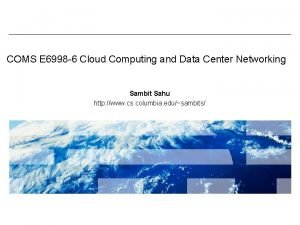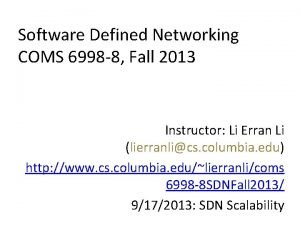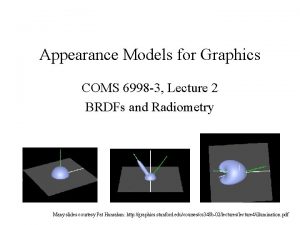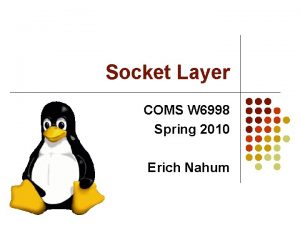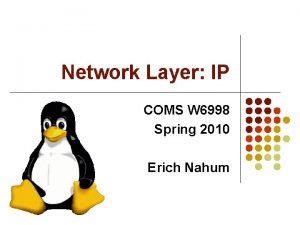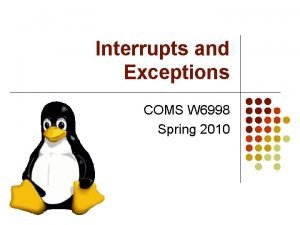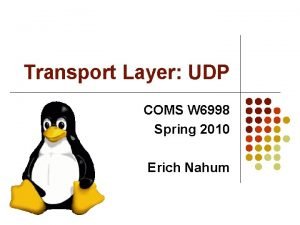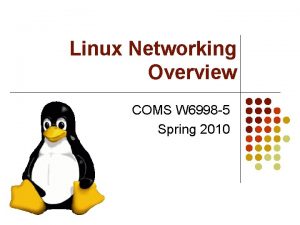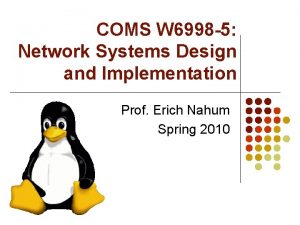Network Devices COMS W 6998 Spring 2010 Erich



![net_device members l l l l char name[IFNAMSIZ] - name of the network device, net_device members l l l l char name[IFNAMSIZ] - name of the network device,](https://slidetodoc.com/presentation_image_h/73ea7a83f8bec96f79a53e35aef2732c/image-4.jpg)






- Slides: 10

Network Devices COMS W 6998 Spring 2010 Erich Nahum

Network Devices l l An interface between software-based protocols and network adapters (hardware). Two major functions: l l l Abstract from the technical properties of network adapters (that implement different layer-1 and layer-2 protocols and are manufactured by different vendors). Provide a uniform interface for access by protocol instances. Represented in Linux by a struct net_device l include/linux/netdevice. h

Struct net_device_ops l l l The methods of a network interface. The most important ones: l ndo_init(), called once when the device is registered l ndo_open(), called when the network interface is up'ed l ndo_close(), called when the network interface is down'ed l ndo_start_xmit(), to start the transmission of a packet l ndo_tx_timeout(), callback for when tx doesn’t progress in time And others: l ndo_get_stats(), to get statistics l ndo_do_ioctl(), to implement device specific operations l ndo_set_rx_mode(), to select promiscuous, multicast, etc. l ndo_set_mac_address(), to set the MAC address l ndo_set_multicast_list(), to set multicast filters The netdev_ops field in the struct net_device structure must be set to point to the struct net_device_ops structure.
![netdevice members l l l l char nameIFNAMSIZ name of the network device net_device members l l l l char name[IFNAMSIZ] - name of the network device,](https://slidetodoc.com/presentation_image_h/73ea7a83f8bec96f79a53e35aef2732c/image-4.jpg)
net_device members l l l l char name[IFNAMSIZ] - name of the network device, e. g. , eth 0 -eth 4, lo (loopback device) unsigned int mtu – Maximum Transmission Unit: the maximum size of frame the device can handle. unsigned int irq – irq number. unsigned char *dev_addr : hw MAC address. int promiscuity – a counter of the times a NIC is told to set to work in promiscuous mode; used to enable more than one sniffing client. struct net_device_stats – statistics struct net_device_ops *netdev_ops – netdev ops

net_device->flags l flags: properties of the network device l l l l IFF_UP: the device is on. IFF_BROADCAST: the device is broadcast-enabled. IFF_DEBUG: debugging is turned on. IFF_LOOKBACK: the device is a loopback network device. IFF_POINTTOPOINT: this is a point-to-point connection. IFF_PROMISC: this flag switches the promiscuous mode on. IFF_MULTICAST: activates the receipt of multicast packets. IFF_NOARP: doesn’t support ARP

net_device->features l features: features of the network device l l l l l NETIF_F_SG: supports scatter-gather. NETIF_F_IP_CSUM: supports TCP/IP checksum offload. NETIF_F_NO_CSUM: checksum not needed (loopback). NETIF_F_HW_CSUM: supports all checksums. NETIF_F_FRAGLIST: supports scatter-gather. NETIF_F_HW_VLAN_TX: hardware support for VLANs. NETIF_F_HW_VLAN_RX: hardware support for VLANs. NETIF_F_GSO: generic segmentation offload NETIF_F_GRO: generic receive offload. NETIF_F_LRO: large receive offload.

net_device allocation l Allocated using: l l And deallocated with l l struct net_device *alloc_netdev(size, mask, setup_func); l size – size of our private data part l mask – a naming pattern (e. g. “eth%d”) l setup_func – A function to prepare the rest of the net_device. void free_netdev(struct *net_device); For Ethernet we have a specialized version: l struct net_device *alloc_etherdev(size); l which calls alloc_netdev(size, “eth%d”, ether_setup);

net_device registration l Registered via: l l int register_netdev(struct net_device *dev); int unregister_netdev(struct net_device dev);

Utility Functions l netif_start_queue() l l netif_stop_queue() l l Tells the kernel to stop sending packets. Useful at driver cleanup of course, but also when all transmission buffers are full. netif_queue_stopped() l l Tells the kernel that the driver is ready to send packets Tells whether the queue is currently stopped or not netif_wake_queue() l Wakeup a queue after a netif_stop_queue(). The kernel will resume sending packets

Network Device Interface Higher Protocol Instances dev. c netif_rx dev_queue_xmit dev_open dev_close Network devices (adapter-independent) Network devices interface net_device dev->hard_start_xmit dev->open dev->stop Abstraction from Adapter specifics driver. c net_rx net_start_xmit net_tx skb net_interrupt skb Network driver net_open net_stop (adapter-specific)

